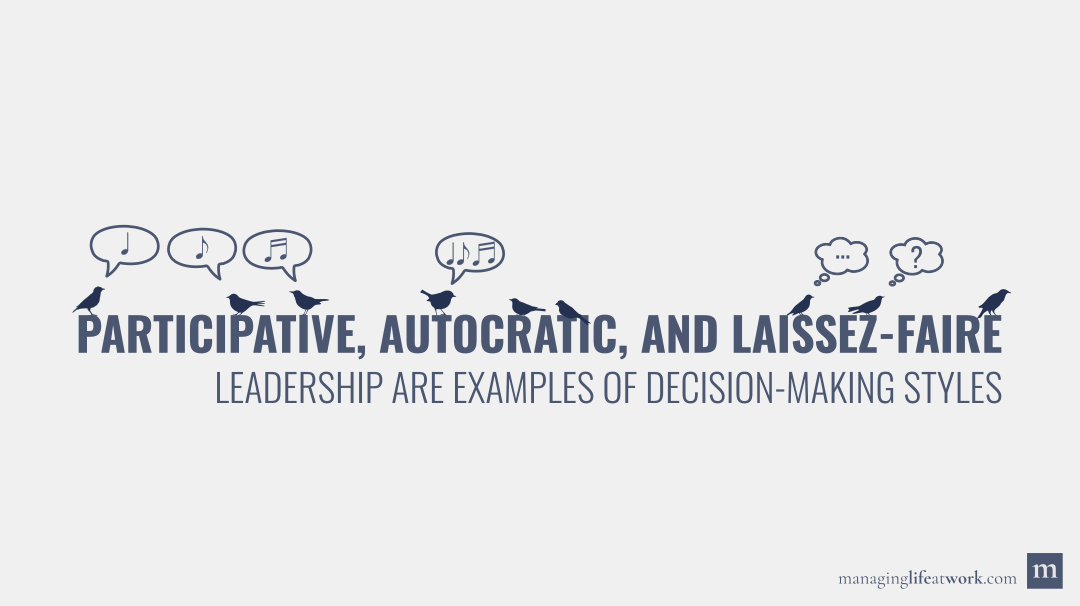Leadership styles are the behavior patterns leaders adopt (what leaders do).
A leadership style comes to life when a unique combination of complementary behaviors co-occur.
Many styles are tied together via underlying commonalities, forming four core types of leadership styles: decision-making leadership styles; everyday leadership styles; beyond everyday-work leadership styles; and values-based leadership styles.
Read on to learn more about leadership styles, the existing types, and the definitions, examples of typical behaviors, and overall effectiveness of the most important styles.
Table of contents
- Definition of leadership styles
- A leadership style is a set of behaviors, not a single behavior
- A leadership style can be adopted automatically or via a monitoring effort
- Leadership styles can include not only behaviors but also personality traits
- There is a difference between a theoretical leadership style and the leadership style of a person
- Different leadership styles can share common behaviors
- Leadership styles are at the forefront of influence
- Types of leadership styles
- Examples of decision-making leadership styles
- Examples of everyday leadership styles
- Examples of beyond everyday-work leadership styles
- Examples of values-based leadership styles
- Conclusion
- References and further reading
Definition of leadership styles
A leadership style is the behavior pattern displayed by a leader. In other words, a leadership style reflects the recurrent way in which a leader acts towards followers.
This definition highlights six important aspects of leadership styles.
A leadership style is a set of behaviors, not a single behavior
First, leadership styles are viewed as complementary behaviors that tend to co-occur frequently.
It is the combined set of related behaviors that form a leadership style, not a behavior in isolation. No behavior alone is able to capture the complexity and requirements of most leadership styles.
For example, authentic leaders are expected to not only stay true to their moral standards, but also to express their ideas clearly, and to seek information from others to better understand situations and themselves[1a] [2a].
This does not mean that, in order to adopt a leadership style, a leader must engage in all specific behaviors of such leadership style at the same time. In contrast, a leader adopting a style engages in specific behaviors over time, as necessary.
A leadership style can be adopted automatically or via a monitoring effort
Each leadership style we display can be the result of an automatic or a monitored effort.
The first is largely unconscious and guides us towards our most habitual leadership style(s). Across situations, we lead in the way that comes to mind and in line with our dominant (go-to) leadership style(s). These automatic leadership styles tend to be adopted when:
- We do not have time to carefully analyze a situation at work, relying instead on a leadership style that is usual to us;
- A leadership style fits our personality and we find it easy to use;
- A leadership style served us well in the past and, as such, we learned to keep using it;
- We are not aware that the situation requires the adoption of a different leadership style.
In contrast, monitored efforts guide us to carefully analyze the situation we are facing as leaders. Based on this assessment, we can choose the leadership style that best fits the situation and regulate our behavior accordingly[3] [4] [5].
Leadership styles can include not only behaviors but also personality traits
Personality traits are an important root of behavior patterns. The stronger a person’s propensity towards a personality trait, the more likely that person engages in a set of behaviors, over time and across situations[6].
This tells us that not every person has the same likelihood of adopting a given leadership style. Certain leadership styles tend to be more frequently adopted by people with certain personality traits.
For example, the transformational leadership style tends to be adopted more often by extroverts than by introverts[7]. Because extroverts tend to be optimistic, talkative, and assertive, they are likely to display transformational leadership behaviors such as enthusing and inspiring followers.
In some leadership styles, however, personality traits and behaviors are so intricate and fuzzy that it is difficult to draw a line separating the two.
For example, in the ethical leadership style[8a] [9a], personality traits and behaviors are so interconnected that it is usually accepted that ethical leadership reflects both
- Traits (such as integrity, morality, fairness, and disposition to reflect upon the consequences of one’s actions);
- And behaviors (such as setting an example at work of how to behave ethically, discussing ethics and values with followers, and addressing violations of ethical standards in the workplace).
There is a difference between a theoretical leadership style and the leadership style of a person
In theory, a leadership style is a set of complementary behaviors that tend to co-occur frequently. After identifying a new behavioral set in leadership, researchers and practitioners attribute a descriptive name to it. Transformational leadership, ethical leadership, and servant leadership are examples.
In practice, many leaders end up adopting styles that are combinations of theoretical leadership styles[10]. It is very rare to see leaders adopting a leadership style that perfectly matches the theoretical model.
This may happen because a specific behavior is not relevant for a particular job, or because a leader finds out that the most effective way to lead in a given context is to mix and match behaviors from different styles and theoretical models.
For example:
- Most effective transformational leaders are also transactional[11] [12] [13];
- Leadership effectiveness is boosted when leaders focus both on structuring followers’ work and on showing consideration towards followers[14a].
- Followers performance is enhanced when leaders pair a visionary leadership style with an empowering style[15a].
Nevertheless, theoretical models are particularly useful to identify meaningful sets of behaviors, to map out the available sets of behaviors for leaders, and to identify the consequences of specific leadership styles.
Different leadership styles can share common behaviors
Some leadership styles are narrow and focused on a limited set of behaviors. Others are broader, encompassing multiple sets of behavior.
As a consequence, many broader leadership styles end up encompassing behaviors from narrowly defined leadership styles. In such cases, the narrow leadership style is a necessary aspect of the broader leadership style, but not a sufficient condition to claim that the broader leadership style is being adopted.
For example, while participative leadership is a style in itself, the broader style of empowering leadership also includes followers’ participation in decision making, among other aspects[16a].
Likewise, many broad leadership styles share common sets of behavior.
For example, being honest and acting with integrity is expected from authentic, ethical, and servant leaders. The other behaviors displayed by the leader will define the actual leadership style taking place.
Leadership styles are at the forefront of influence
Since leadership styles reflect the overt and observable actions of a leader, they are at the forefront of influence in organizations.
In fact, large scale studies indicate that leadership styles have stronger effects on effectiveness than leaders’ traits and skills[17a].
Followers derive what leaders value, what to do at work, and how to achieve goals largely based on what they see leaders doing. When leaders adopt a leadership style they serve as role model to many followers, who end up emulating leader’s attitudes, values, and behaviors[18a] [19a] [20].
Further, followers obtain clues about their leaders’ underlying traits and skills based on the leadership style displayed. Because traits and skills tend to be less observable than behaviors, personality traits and skills are largely inferred or communicated. Followers infer and attribute leadership traits and skills partially based on the styles their leaders adopt.
Types of leadership styles
The list of leadership styles is extensive. However, many styles are tied together via shared commonalities in their core approach, goals, and focus[17b] [21a].
In the table below, we list the most established and scientifically studied leadership styles, organized into four broad types of leadership according to their main approach, goal, and/or focus.
Table 1. Typology of leadership styles along with examples.
| Types of leadership styles | Examples of leadership styles |
| Decision-making leadership styles |
Participative leadership Autocratic leadership Laissez-faire leadership |
| Everyday leadership styles |
Consideration style of leadership Initiating structure style of leadership Transactional leadership style |
| Beyond everyday-work leadership styles |
Visionary leadership Transformational leadership |
| Values-based leadership styles |
Ethical leadership Authentic leadership Servant leadership |
In using this typology of leadership styles, keep in mind that most leadership styles also have important roles outside their main type.
For example, while the central aspect of decision-making leadership styles is how leaders make decisions, these styles also have important ramifications form everyday work and for the values that leaders signal to others.
Decision-making leadership styles
Decision-making styles look at when, and to what extent, leaders involve followers in generating and choosing alternatives to solve problems at work[22a] [23].
The focus here is not on the decision that is made, but rather on how leaders reach the decision: autocratically, with the participation of followers, or being hands off (laissez-faire).
Everyday leadership styles
In addition to make decisions, leaders also have to ensure that everyday work runs smoothly and that followers are performing as expected.
After listing virtually all the behaviors leaders have to engage in on a daily basis, researchers found that almost all behaviors fall into either the consideration style (focus on showing concern and respect for employees) or the initiating structure style (focus on goal attainment)[14b] [24].
Later, researchers identified transactional leadership as a specific form of structuring leadership, focused on rewarding and disciplining followers depending on their effectiveness[17c].
Beyond everyday-work leadership styles
Everyday leadership styles tend to deliver expected outcomes, but usually fail to sustain extraordinary performance and innovative change[18b].
Hence the emergence of leadership styles focused, at their core, on influencing effectiveness beyond what is expected in everyday work and on creating meaningful work environments. Among the most well-established and promising styles are transformational leadership, visionary leadership, and empowering leadership.
Due to their properties, these beyond everyday-work leadership styles are also called inspirational[21b] and change-oriented[17d] leadership styles.
Values-based leadership styles
The values-based leadership styles represent behaviors rooted on morality, community values, and continuous improvement[21c].
It represents a shift in the focus of leadership behavior – specifically, from influencing the achievement of results to influencing how results are achieved.
Values-based, moral, and ethical behaviors are encapsulated in ethical leadership, servant leadership, and authentic leadership.
Examples of decision-making leadership styles
Below are the definitions, behavioral acts, and overall effectiveness of decision-making leadership styles.
Participative leadership
Participative leaders engage in decision procedures that allow followers to have an active role in making and implementing decisions at work[25].
In doing so, participative leaders share some or all of their influence to draw on followers’ ability, information, and competence to make decisions and solve problems[26].
Participative leaders tend to engage in one or more of the following decision procedures[27]:
- Consultation
- Leaders decide alone but ask followers to express their ideas and take their suggestions into consideration while deciding;
- Leaders encourage followers to express their ideas on a daily basis so that other positions can be considered when leaders make their own decisions;
- Leaders gather information from followers during informal and casual gatherings to enrich their own decision-making.
- Joint decision
- Leaders and followers voice their positions, discuss possibilities and, together and with the same level of influence, make the final decision;
- Leaders encourage followers to continuously acquire new competences so that everyone can participate equally, and in an informed way, in the decision-making process;
- Leaders adopt a facilitator role so that a majority/consensual decision is reached.
- Delegation
- Leaders defer the responsibility of making a decision to followers, by defining upfront an acceptable range for the decision;
- Leaders give followers the authority to decide but the implementation needs leaders’ approval;
- Leaders give followers the authority to decide and to implement the decision.
Autocratic leadership
Autocratic leaders behave in a way that asserts their authority, power, and control, and they expect followers’ obedience and compliance[33].
Typically, autocratic leaders:
- Make decisions on their own, without involving followers;
- Enforce strict deadlines for goal achievement, and request intense work efforts to achieve goals on time;
- Are critical of the ideas and suggestions presented by followers;
- Tell followers how to perform tasks and the procedures to adopt without explanations;
- Ensure that their regulations are being followed by monitoring followers’ work.
It is important to note that autocratic leaders focus on control and obedience, not on being abusive towards followers[34]. As such, autocratic leadership is not considered a destructive form of leadership and tends to be effective in some circumstances.
For example, in harsh economic environments, autocratic leaders outperform transformational leaders in boosting firm revenue[35]. Likewise, autocratic leadership enhances the performance of followers who respect and believe in the value of hierarchies[36]. Adopting an autocratic style also tends to boost effectiveness when leaders have control over the resources required to achieve something and have a clear understanding of what needs to be done[37a].
On the negative side, autocratic leadership can leave some followers unsatisfied with their job[38], less prone to voice ethical concerns[39], and experiencing work stress[40].
Laissez-faire leadership
The delegating form of participative leadership and the laissez-faire leadership may seem similar on the surface, but they are quite different:
- Laissez-faire leadership is a passive and avoidant style of leadership focused on ignoring responsibilities in situations where the leader intervention would be necessary;
- Delegating is an active style of leadership focused on approaching decisions and solving problems at work by giving great depths of authority to followers.
Typically, laissez-faire leaders engage in one or more of the following sets of behavior[42] [43]:
- Decision-making avoidance
- Avoid making decisions and getting involved in important issues;
- Turn a blind eye to situations at work that would most likely require attention and intervention;
- Avoid paying attention to and tackling problems that emerge at work, even when those problems become acute or chronic.
- Unresponsiveness to requests
- Are absent when followers need them and fail to provide the information followers need to work effectively;
- Are indifferent about followers’ requests for support and about their needs at work;
- Are unavailable to help followers solve problems, conflicts, or disputes among them.
- Reward omission
- Do not praise followers when they perform very well at work;
- Do not acknowledge followers’ extra efforts at work;
- Do nothing when followers achieve important work milestones.
- Punishment omission
- Do not give feedback nor constructive criticism when followers perform poorly;
- Do not intervene when followers are slaking off and getting behind on tasks;
- Do nothing when followers fail at work or miss important deadlines.
Laissez-faire leadership tends to be severely detrimental to the effectiveness, satisfaction, and well-being of followers[44] [45] [46a]. These negative consequences of laissez-faire leadership may happen because followers see themselves[47]:
- Loosing clarity over what is expected from them;
- Becoming ambivalent and in conflict regarding the depth of their role at work;
- Clashing with one another as responsibilities and acceptable behavior at work become blurred.
While teaching leadership and training leaders, we have seen that the most common regret of leaders is turning a blind eye to issues and avoiding problems (that is, engaging in laissez-faire leadership). It can be useful to postpone solving a problem, but it is rarely beneficial to avoid looking at a problem or to pretend that it does not exist.
In the video below, Dr. Alex Lyon (from State University of New York) adopts a complementary communication perspective to go through participative, autocratic, and laissez-faire leadership styles:
Examples of everyday leadership styles
Read on for the definitions, typical behaviors, and overall effectiveness of everyday leadership styles.
Consideration style of leadership
Typically, leaders who are considerate:
- Show concern for followers’ problems and take their needs into account;
- Find ways to solve personality clashes and other disagreements between followers;
- Treat followers in a respectful manner;
- Show appreciation for followers’ efforts;
- Touch base with followers before taking actions that may impact them;
- Are approachable and followers feel at ease around them.
This leadership style tends to boost effectiveness through personal support, camaraderie, warmth, and trust. However, we tend to see stronger boosts on followers’ job satisfaction than on job performance[14c] [49a].
The consideration style of leadership also acts as a protective factor of followers’ mental health and as a facilitator of their well-being, as people appreciate to be treated well and meaningfully[50a].
Initiating structure style of leadership
Leaders who initiate structure display task-oriented behaviors and have a prevailing focus on goal attainment[37c]. Leaders who rarely initiate structure tend to be seen as hesitant with regards to taking initiative, and are hands off with regards to how work should be done.
Typically, leaders who initiate structure:
- Organize work, assign followers to tasks, define roles, and schedule work activities;
- Stress that meeting deadlines is crucial;
- Define performance goals and strategies to achieve them;
- Define communication channels and how the information should flow in the team/organization;
- Monitor performance, review results, and give instructions to improve task achievement.
The leadership style of initiating structure tends to enhance effectiveness at work[50b] [51] by:
- Clarifying expectations;
- Reducing ambivalence regarding priorities;
- Providing resources to followers (for example, an effective system of information flow and a clear understanding of what each part of the task entails).
However, the initiating structure style tends to be more relevant to boost followers’ task performance than to enhance other indicators of effectiveness, such as job satisfaction[14d] [49b].
Transactional leadership
The transactional leadership style stems from the formal hierarchical structure of most organizations and emphasizes conditional rewards and disciplinary actions as sources of motivation[18c].
Transactional leaders exchange resources with followers based on self-interest – leaders give followers something they want when followers do what leaders want.
Transactional leaders tend to engage in one or more of the following sets of behavior:
- Contingent reward
- Complimenting followers when they perform well;
- Assigning what needs to be done and promising a reward for carrying out the assignment;
- Negotiating with followers what needs to be done as well as the rewards for a work well done.
- Active management by exception
- Monitoring followers to anticipate problems;
- Watching closely whether followers violate important rules so that corrective actions (negative reinforcement, criticism) can be implemented before or when it happens;
- Actively looking for mistakes from followers so that followers can receive negative feedback and mistakes be corrected in a timely mater.
- Passive management by exception
- Intervening only after standards are not met (with a negative performance evaluation, for example);
- Talking with followers about sub-optimal approaches to work only after serious problems emerge;
- Correcting followers’ behaviors only after serious difficulties have emerged as a consequence of those behaviors.
In terms of effectiveness[17e] [46b] [52]:
- Contingent rewards tend to enhance performance at work;
- The active form of management by exception tends to improve, but only slightly and inconsistently, followers’ performance;
- The passive form of management by exception tends to have detrimental effects on followers’ performance.
Examples of beyond everyday-work leadership styles
Here are the definitions, descriptive behaviors, and overall effectiveness of beyond everyday-wok leadership styles.
Visionary leadership
Visionary leaders communicate an image of the team/organization’s future with the intent of persuading and motivating followers to work on its implementation[53].
Typically, visionary leaders:
- Talk with followers about the future;
- Show a clear understanding of the direction to take and of the opportunities ahead;
- Clearly state their plans for the future and where the team/organization is going;
- Clearly communicate expected accomplishments;
- Show a clear understanding of the critical goals of the team/organization and how followers can work together to achieve them.
This leadership style tends to enhance performance at work by clarifying goals and instilling a shared sense of purpose in followers[15b] [54]. Visionary leadership also tends to boost innovation and change, since articulating a vision is usually the starting point for a leader targeting change[55].
Here is a video, from speaker coach Noah Zandan, with three tips on how leaders can communicate their vision more effectively:
Transformational leadership
Transformational leaders inspire followers to transcend self-interest, to believe they can achieve great things, to identify with the leaders’ vision, and to commit to the collective mission[18d].
Transformational leaders tend to display four sets of behavior[56] [57]:
- Idealized influence
- Setting an example in terms of ethics and morality;
- Showing that collective good prevails over self-interests;
- Showing confidence, persistence, and determination in the face of obstacles;
- Self-sacrificing to benefit the team/organization.
- Inspirational motivation
- Talking positively and optimistically about the future;
- Presenting a meaningful vision for the future and explaining how to attain it;
- Setting high expectations on what is to be achieved;
- Emphasizing values to be endorsed with emotional appeals and symbolic actions.
- Intellectual stimulation
- Challenging followers to rethink problems with fresh and new perspectives;
- Questioning sub-optimal approaches and assumptions;
- Reframing problems to find creative solutions;
- Encouraging the implementation of new procedures and ways of doing things at work.
- Individualized consideration
- Providing quality support to followers at work;
- Listening to followers’ concerns and doubts;
- Identifying the improvement opportunities of each follower and supporting their improvement;
- Mentoring the growth of followers and nurturing their potential.
The transformational leadership style tends to enhance effectiveness at work by boosting followers’ positive affect, confidence, motivation, engagement, and perceptions of a fair and trustworthy workplace[58].
By inspiring followers, transformational leaders also end up developing high quality relationships with them. In such relationships the norm of reciprocity prevails – followers reciprocate the relationship growth with increased effectiveness and morale at work[59].
Transformational leadership is a style particularly suitable for leading change and innovation[60]. It tends to make followers more committed, open, ready, and supportive of change and innovation, while reducing their natural resistance and doubts[61].
Empowering leadership
Empowering leaders share power with followers and support followers’ development, autonomy, and self-reliance[16b] [62].
Typically, empowering leaders:
- Encourage followers to solve problems as they pop up, without leaders’ supervision, input, or approval;
- Provide the discretion and leeway for followers to do their work as they see fit;
- Decide, together with followers, performance goals and related rewards;
- Highlight and explain the relevance of followers’ work to the organization;
- Make decisions with followers and, when participation in decision making is not possible, take time to explain the rationale behind their decisions;
- Express confidence in followers’ ability to carry out their work successfully;
- Encourage followers to seek out learning opportunities and to enrich their skills repertoire;
- Share how they structure their days and plan their work, and tip followers on improvement opportunities.
This leadership style tends to enhance performance at work and followers’ willingness to go the extra mile by[63] [64]:
- Promoting a vibrant environment where learning and adaptation are paramount;
- Boosting followers’ motivation through psychological empowerment;
- Increasing followers’ willingness to reciprocate the trust and confidence leaders’ deposit on them.
Empowering leadership is particularly effective in promoting innovation and creativity at work[65] [66]. The autonomy, self-belief, and intrinsic motivation that followers experience around empowering leaders leave them in a privileged position to explore new ideas and to find ways to implement them in the workplace.
Examples of values-based leadership styles
Read on for the definitions, characteristic behaviors, and overall effectiveness of values-based leadership styles.
Ethical leadership
Ethical leadership is grounded on leaders’ prosocial values and moral emotions[68]. Ethical leaders signal their prosocial values by engaging in behaviors that benefit and cause no harm to others. Moral emotions propel ethical leaders to:
- Get back on track when they derail ethically (with shame and guilt);
- Condemn followers when they violate important norms (with anger, irritation, and disgust);
- Understand the suffering of others (with compassion and sympathy);
- Praise the ethical elevation of followers’ actions (with awe, admiration, and gratitude).
Typically, ethical leaders:
- Are fair, trustworthy, honest, and act with integrity;
- Do what is right and ethical even when facing temptations and difficulties;
- Are supportive and caring when followers face difficulties at work;
- Reward followers’ ethical behaviors and punish their unethical behaviors;
- Clearly communicate ethical standards to be followed at work;
- Include ethical behavior in the assessment of followers’ effectiveness – they look both at the results and at the way they were achieved;
- Hold everyone accountable (leader and followers) for mistakes and accomplishments, and for unethical and ethical practices;
- Make sacrifices to benefit everyone that, directly or indirectly, are affected by their practices (followers, organization, clients, investors).
This leadership style tends to be particularly useful to enhance ethical behavior at work, and to prevent unethical behavior and turnover[9b] [69].
Nevertheless ethical leadership can also enhance followers’ performance and willingness to go the extra mile[70] [71] through:
- The development of high quality, dependable, and trusting relationships;
- The development of an ethical culture that sustains the additional efforts that are often required to achieve great things in an ethical way;
- The identification with the virtuous values that leaders display and encourage.
Authentic leadership
Authentic leadership has personal, relational, and developmental aspects to it[1b] [2b] [72].
Personally, authentic leaders understand and act in keeping with who they are, their purpose, and their values. The relational aspect manifests in the development of transparent, genuine, open, and honest relationships with followers. Also, authentic leaders emphasize development and continuous improvement (in themselves and in followers).
Authentic leaders display four sets of behavior:
- Relational transparency
- Tell the truth and admit their own mistakes;
- Express emotions that are both genuine and appropriate to the situation at hand;
- Clearly articulate their thoughts and what they mean.
- Self-awareness
- Seek feedback from others to better understand their strengths and weaknesses;
- Have a learning, non-defensive, orientation towards feedback and mistakes;
- Understand the impact they have on others, as leaders;
- Unbiased processing
- Seek opposing views and thoroughly analyze all the available information before making a decision;
- Look up for information that may challenge their beliefs and positions;
- Encourage followers to voice all their views (both supporting and opposing) on an issue.
- Internalized moral perspective
- Stay true to their moral standards through consistent behavior;
- Act consistently in line with their beliefs and values;
- Do not bend to pressures that go against their moral standards neither fall prey to moral disengagement.
Authentic leaders tend to thrive in ethical environments as it tends to be safer and easier to admit mistakes in such workplaces[73a]. In unethical environments, authentic leaders can become vulnerable to unethical tactics and a target of questionable political moves.
Authentic leadership tends to be particularly effective to enhance collective performance, followers’ willingness to go the extra mile, and followers’ ethical behavior in the face of temptation[74] [75]. These results are rooted on the high quality and trusting relationships that authentic leaders develop with their followers due to their consistency and openness[9c] [73b].
Servant leadership
Servant leaders[19b]:
- Are oriented towards serving others;
- Focus on followers’ needs, interests, and holistic growth;
- Show concern for the wider community and for multiple stakeholders.
These three features of servant leadership tend to manifest through seven sets of behavior[76] [77] [78]:
- Emotional healing
- Caring about followers’ well-being and personal struggles;
- Taking time to help followers to cope with their personal problems.
- Adding value for the broader community
- Being involved with and helping the community that is affected, directly or indirectly, by the organization;
- Encouraging followers to have an active role in the community surrounding the organization.
- Conceptual skills
- Having a deep and clear understanding of how the organization works, of its priorities, and of its goals;
- Showing competency by anticipating and solving work problems with complex decision making and creativity.
- Empowering
- Encouraging followers to make decisions autonomously;
- Giving followers freedom to decide how to deal with problems and how to tackle tasks at work.
- Supporting followers’ growth and success
- Understanding and supporting followers’ careers and goals;
- Sharing insights and opportunities that can help followers to achieve their full potential.
- Putting followers first
- Prioritizing followers needs and interests over their own needs and interests;
- Making an effort to simplify and enrich followers’ work.
- Behaving ethically
- Being honest and showing integrity in everyday actions;
- Consistently following ethical standards, even in the face of temptations.
Servant leaders tend to drive effectiveness because they:
- Increase followers’ job satisfaction and satisfy followers’ basic psychological needs of competence, autonomy, and relatedness[79] [80];
- Develop high quality relationships with followers based on trust and fairness[81] [82];
- Create a serving culture that direct followers’ attention to serving the community and all the stakeholders involved[83].
Servant leadership is one of the most promising leadership styles in the sense that it tends to boost effectiveness over and above other well-established leadership styles, such as transformational leadership and ethical leadership[9d]. Also, due to their community and stakeholder focus, servant leaders are at the forefront of sustainable and socially responsible organizational practices[84].
In the video below, Dr. James Lemoine (The State University of New York), Dr. Chad Hartnell (Georgia State University), and Dr. Hannes Leroy (Erasmus University) discuss how ethical, authentic, and servant leadership overlap, along with what distinguishes these leadership styles.
Conclusion
Behaviors are the building blocks of leadership styles. When a pattern of complementary behaviors occur, we witness a leadership style coming to life.
Understanding which types of leadership styles leaders can rely on, and knowing the defining behaviors of the most important styles can leave us better prepared to face the challenges ahead.
As always, we thank you for trusting your time with ManagingLifeAtWork.com. Until next time, keep leading effectively and keep an informed eye on leadership styles.
References and further reading
- ^ a b Neider, L. L., and Schriesheim, C. A. (2011). “The Authentic Leadership Inventory (ALI): Development and empirical tests“. The Leadership Quarterly, 22, 1146–1164.
- ^ a b Walumbwa, F. O., Avolio, B. J., Gardner, W. L., Wernsing, T. S., and Peterson, S. J. (2008). “Authentic leadership: Development and validation of a theory-based measure“. Journal of Management, 34, 89–126.
- ^ Day, D. V., Shleicher, D. J., Unckless, A. L., and Hiller, N. J. (2002). “Self-monitoring personality at work: A meta-analytic investigation of construct validity“. Journal of Applied Psychology, 87, 390–401.
- ^ Foti, R. J., and Hauenstein, N. M. A. (2007). “Pattern and variable approaches in leadership emergence and effectiveness“. Journal of Applied Psychology, 92, 347–355.
- ^ Yukl, G., and Mahsud, R. (2010). “Why flexible and adaptive leadership is essential“. Consulting Psychology Journal: Practice and Research, 62, 81–93.
- ^ Fleeson, W. (2001). “Toward a structure- and process-integrated view of personality: Traits as density distributions of states“. Journal of Personality and Social Psychology, 80, 1011–1027.
- ^ Bono, J. E., and Judge, T. A. (2004). “Personality and transformational and transactional leadership: A meta-analysis“. Journal of Applied Psychology, 89, 901–910.
- ^ a b Brown, M. E., Treviño, L. K., and Harrison, D. A. (2005). “Ethical leadership: A social learning perspective for construct development and testing“. Organizational Behavior and Human Decision Processes, 97, 117–134.
- ^ a b c d Hoch, J. E., Bommer, W. H., Dulebohn, J. H., and Wu, D. (2018). “Do ethical, authentic, and servant leadership explain variance above and beyond transformational leadership? A meta-analysis“. Journal of Management, 44, 501–529.
- ^ Rowold, J., Borgmann, L., and Diebig, M. (2015). “A “Tower of Babel”? – interrelations and structure of leadership constructs“. Leadership & Organization Development Journal, 36, 137–160.
- ^ Gavan O’Shea, P., Foti, R. J., Hauenstein, N. M. A., and Bycio, P. (2009). “Are the best leaders both transformational and transactional? A pattern-oriented analysis“. Leadership, 5, 237–259.
- ^ Rowold, J., and Heinitz, K. (2007). “Transformational and charismatic leadership: Assessing the convergent, divergent and criterion validity of the MLQ and the CKS“. The Leadership Quarterly, 18, 121–133.
- ^ Wang, G., Oh, I.-S., Courtright, S. H., and Colbert, A. E. (2011). “Transformational leadership and performance across criteria and levels: A meta-analytic review of 25 years of research“. Group & Organization Management, 36, 223–270.
- ^ a b c d Judge, T. A., Piccolo, R. F., and Ilies, R. (2004). “The forgotten ones? The validity of consideration and initiating structure in leadership research“. Journal of Applied Psychology, 89, 36–51.
- ^ a b Kearney, E., Shemla, M., van Knippenberg, D., and Scholz, F. A. (2019). “A paradox perspective on the interactive effects of visionary and empowering leadership“. Organizational Behavior and Human Decision Processes, 155, 20–30.
- ^ a b Cheong, M., Yammarino, F. J., Dionne, S. D., Spain, S. M., and Tsai, C.-Y. (2019). “A review of the effectiveness of empowering leadership“. The Leadership Quarterly, 30, 34–58.
- ^ a b c d e Derue, D. S., Nahrgang, J. D., Wellman, N., and Humphrey, S. E. (2011). “Trait and behavioral theories of leadership: An integration and meta-analytic test of their relative validity“. Personnel Psychology, 64, 7–52.
- ^ a b c d Bass, B. M., and Riggio, R. E. (2006). “Transformational leadership” (2nd ed.). Mahwah, N.J: L. Erlbaum Associates.
- ^ a b Eva, N., Robin, M., Sendjaya, S., van Dierendonck, D., and Liden, R. C. (2019). “Servant leadership: A systematic review and call for future research“. The Leadership Quarterly, 30, 111–132.
- ^ Ogunfowora, B. (2014). “It’s all a matter of consensus: Leader role modeling strength as a moderator of the links between ethical leadership and employee outcomes“. Human Relations, 67, 1467–1490.
- ^ a b c Banks, G. C., Gooty, J., Ross, R. L., Williams, C. E., and Harrington, N. T. (2018). “Construct redundancy in leader behaviors: A review and agenda for the future“. The Leadership Quarterly, 29, 236–251.
- ^ a b Lewin, K., Lippitt, R., and White, R. K. (1939). “Patterns of aggressive behavior in experimentally created “social climates”“. The Journal of Social Psychology, 10, 271–299.
- ^ Vroom, V. H. (2003). “Educating managers for decision making and leadership“. Management Decision, 41, 968–978.
- ^ Fleishman, E. A. (1953). “The description of supervisory behavior“. Journal of Applied Psychology, 37, 1–6.
- ^ Yukl, G. A. (2013). “Leadership in organizations” (8th ed.). Boston: Pearson.
- ^ Chang, Y.-Y., Hodgkinson, I., Hughes, P., and Chang, C.-Y. (2019). “The mediation between participative leadership and employee exploratory innovation: Examining intermediate knowledge mechanisms“. Leadership & Organization Development Journal, 40, 334–355.
- ^ Heller, F. A., and Wilpert, B. (1977). “Limits to participative leadership: Task, structure and skill as contingencies – a German-British comparison“. European Journal of Social Psychology, 7, 61–84.
- ^ Huang, S. Y. B., Li, M.-W., and Chang, T.-W. (2021). “Transformational leadership, ethical leadership, and participative leadership in predicting counterproductive work behaviors: Evidence from financial technology firms“. Frontiers in Psychology, 12, 658727.
- ^ Miao, Q., Newman, A., Schwarz, G., and Xu, L. (2013). “Participative leadership and the organizational commitment of civil servants in China: The mediating effects of trust in supervisor“. British Journal of Management, 24, S76–S92.
- ^ Huang, X., Iun, J., Liu, A., and Gong, Y. (2010). “Does participative leadership enhance work performance by inducing empowerment or trust? The differential effects on managerial and non-managerial subordinates“. Journal of Organizational Behavior, 31, 122–143.
- ^ Li, G., Liu, H., and Luo, Y. (2018). “Directive versus participative leadership: Dispositional antecedents and team consequences“. Journal of Occupational and Organizational Psychology, 91, 645–664.
- ^ Usman, M., Ghani, U., Cheng, J., Farid, T., and Iqbal, S. (2021). “Does participative leadership matters in employees’ outcomes during COVID-19? Role of leader behavioral integrity“. Frontiers in Psychology, 12, 646442.
- ^ Harms, P. D., Wood, D., Landay, K., Lester, P. B., and Vogelgesang Lester, G. (2018). “Autocratic leaders and authoritarian followers revisited: A review and agenda for the future“. The Leadership Quarterly, 29, 105–122.
- ^ Aasland, M. S., Skogstad, A., Notelaers, G., Nielsen, M. B., and Einarsen, S. (2010). “The prevalence of destructive leadership behaviour“. British Journal of Management, 21, 438–452.
- ^ Huang, X., Xu, E., Chiu, W., Lam, C., and Farh, J.-L. (2015). “When authoritarian leaders outperform transformational leaders: Firm performance in a harsh economic environment“. Academy of Management Discoveries, 1, 180–200.
- ^ Schaubroeck, J. M., Shen, Y., and Chong, S. (2017). “A dual-stage moderated mediation model linking authoritarian leadership to follower outcomes“. Journal of Applied Psychology, 102, 203–214.
- ^ a b c Bass, B. M., and Bass, R. (2009). “The Bass handbook of leadership: Theory, research, and managerial applications” (4th ed.). New York: Free Press.
- ^ Foels, R., Driskell, J. E., Mullen, B., and Salas, E. (2000). “The effects of democratic leadership on group member satisfaction“. Small Group Research, 31, 676–701.
- ^ Zheng, Y., Graham, L., Farh, J.-L., and Huang, X. (2021). “The impact of authoritarian leadership on ethical voice: A moderated mediation model of felt uncertainty and leader benevolence“. Journal of Business Ethics, 170, 133–146.
- ^ Briker, R., Walter, F., and Cole, M. S. (2021). “Hurry up! The role of supervisors’ time urgency and self‐perceived status for autocratic leadership and subordinates’ well‐being“. Personnel Psychology, 74, 55–76.
- ^ Einarsen, S., Aasland, M. S., and Skogstad, A. (2007). “Destructive leadership behaviour: A definition and conceptual model“. The Leadership Quarterly, 18, 207–216.
- ^ Hinkin, T. R., and Schriesheim, C. A. (2008). “An examination of “nonleadership”: From laissez-faire leadership to leader reward omission and punishment omission“. Journal of Applied Psychology, 93, 1234–1248.
- ^ Hinkin, T. R., and Schriesheim, C. A. (2008). “A theoretical and empirical examination of the transactional and non-leadership dimensions of the Multifactor Leadership Questionnaire (MLQ)“. The Leadership Quarterly, 19, 501–513.
- ^ Dumdum, U. R., Lowe, K. B., and Avolio, B. J. (2013). “A meta-analysis of transformational and transactional leadership correlates of effectiveness and satisfaction: An update and extension“. In B. J. Avolio & F. J. Yammarino (Eds.), Monographs in Leadership and Management (Vol. 5, pp. 39–70). Emerald.
- ^ Fosse, T. H., Skogstad, A., Einarsen, S. V., and Martinussen, M. (2019). “Active and passive forms of destructive leadership in a military context: a systematic review and meta-analysis“. European Journal of Work and Organizational Psychology, 28, 708–722.
- ^ a b Judge, T. A., and Piccolo, R. F. (2004). “Transformational and transactional leadership: A meta-analytic test of their relative validity“. Journal of Applied Psychology, 89, 755–768.
- ^ Skogstad, A., Einarsen, S., Torsheim, T., Aasland, M. S., and Hetland, H. (2007). “The destructiveness of laissez-faire leadership behavior“. Journal of Occupational Health Psychology, 12, 80–92.
- ^ Fleishman, E. A., and Harris, E. F. (1962). “Patterns of leadership behavior related to employee grievances and turnover“. Personnel Psychology, 15, 43–56.
- ^ a b Piccolo, R. F., Bono, J. E., Heinitz, K., Rowold, J., Duehr, E., and Judge, T. A. (2012). “The relative impact of complementary leader behaviors: Which matter most?“. The Leadership Quarterly, 23, 567–581.
- ^ a b Montano, D., Reeske, A., Franke, F., and Hüffmeier, J. (2017). “Leadership, followers’ mental health and job performance in organizations: A comprehensive meta-analysis from an occupational health perspective“. Journal of Organizational Behavior, 38, 327–350.
- ^ Fisher, B. M., and Edwards, J. E. (1988). “Consideration and initiating structure and their relationships with leader effectiveness: A meta-analysis“. Academy of Management Proceedings, 1988, 201–205.
- ^ Young, H. R., Glerum, D. R., Joseph, D. L., and McCord, M. A. (2021). “A meta-analysis of transactional leadership and follower performance: double-edged effects of LMX and empowerment“. Journal of Management, 47, 1255–1280.
- ^ van Knippenberg, D., and Stam, D. (2014). “Visionary leadership“. In D. V. Day (Ed.), The Oxford handbook of leadership and organizations (pp. 241–259). Oxford, UK: Oxford University Press.
- ^ Carton, A. M., Murphy, C., and Clark, J. R. (2014). “A (blurry) vision of the future: How leader rhetoric about ultimate goals influences performance“. Academy of Management Journal, 57, 1544–1570.
- ^ Griffin, M. A., Parker, S. K., and Mason, C. M. (2010). “Leader vision and the development of adaptive and proactive performance: A longitudinal study“. Journal of Applied Psychology, 95, 174–182.
- ^ Bass, B. M., Avolio, B. J., Jung, D. I., and Berson, Y. (2003). “Predicting unit performance by assessing transformational and transactional leadership“. Journal of Applied Psychology, 88, 207–218.
- ^ Podsakoff, P. M., MacKenzie, S. B., and Bommer, W. H. (1996). “Transformational leader behaviors and substitutes for leadership as determinants of employee satisfaction, commitment, trust, and organizational citizenship behaviors“. Journal of Management, 22, 259–298.
- ^ Ng, T. W. H. (2017). “Transformational leadership and performance outcomes: Analyses of multiple mediation pathways“. The Leadership Quarterly, 28, 385–417.
- ^ Wang, H., Law, K. S., Hackett, R. D., Wang, D., and Chen, Z. X. (2005). “Leader-member exchange as a mediator of the relationship between transformational leadership and followers’ performance and organizational citizenship behavior“. Academy of Management Journal, 48, 420–432.
- ^ Watts, L. L., Steele, L. M., and Den Hartog, D. N. (2020). “Uncertainty avoidance moderates the relationship between transformational leadership and innovation: A meta-analysis“. Journal of International Business Studies, 51, 138–145.
- ^ Peng, J., Li, M., Wang, Z., and Lin, Y. (2021). “Transformational leadership and employees’ reactions to organizational change: Evidence from a meta-analysis“. The Journal of Applied Behavioral Science, 57, 369–397.
- ^ Amundsen, S., and Martinsen, Ø. L. (2014). “Empowering leadership: Construct clarification, conceptualization, and validation of a new scale“. The Leadership Quarterly, 25, 487–511.
- ^ Burke, C. S., Stagl, K. C., Klein, C., Goodwin, G. F., Salas, E., and Halpin, S. M. (2006). “What type of leadership behaviors are functional in teams? A meta-analysis“. The Leadership Quarterly, 17, 288–307.
- ^ Lee, A., Willis, S., and Tian, A. W. (2018). “Empowering leadership: A meta-analytic examination of incremental contribution, mediation, and moderation“. Journal of Organizational Behavior, 39, 306–325.
- ^ Kim, M., Beehr, T. A., and Prewett, M. S. (2018). “Employee responses to empowering leadership: A meta-analysis“. Journal of Leadership & Organizational Studies, 25, 257–276.
- ^ Zhang, X., and Bartol, K. M. (2010). “Linking empowering leadership and employee creativity: The influence of psychological empowerment, intrinsic motivation, and creative process engagement“. Academy of Management Journal, 53, 107–128.
- ^ Yukl, G., Mahsud, R., Hassan, S., and Prussia, G. E. (2013). “An improved measure of ethical leadership“. Journal of Leadership & Organizational Studies, 20, 38–48.
- ^ Banks, G. C., Fischer, T., Gooty, J., and Stock, G. (2021). “Ethical leadership: Mapping the terrain for concept cleanup and a future research agenda“. The Leadership Quarterly, 32, 101471.
- ^ Bedi, A., Alpaslan, C. M., and Green, S. (2016). “A meta-analytic review of ethical leadership outcomes and moderators“. Journal of Business Ethics, 139, 517–536.
- ^ Ng, T. W. H., and Feldman, D. C. (2015). “Ethical leadership: Meta-analytic evidence of criterion-related and incremental validity“. Journal of Applied Psychology, 100, 948–965.
- ^ Peng, A. C., and Kim, D. (2020). “A meta‐analytic test of the differential pathways linking ethical leadership to normative conduct“. Journal of Organizational Behavior, 41, 348–368.
- ^ Northouse, P. G. (2021). “Leadership: Theory and practice“. Los Angeles, CA: SAGE Publications.
- ^ a b Zhang, Y., Guo, Y., Zhang, M., Xu, S., Liu, X., and Newman, A. (2022). “Antecedents and outcomes of authentic leadership across culture: A meta-analytic review“. Asia Pacific Journal of Management.
- ^ Banks, G. C., McCauley, K. D., Gardner, W. L., and Guler, C. E. (2016). “A meta-analytic review of authentic and transformational leadership: A test for redundancy“. The Leadership Quarterly, 27, 634–652.
- ^ Cianci, A. M., Hannah, S. T., Roberts, R. P., and Tsakumis, G. T. (2014). “The effects of authentic leadership on followers’ ethical decision-making in the face of temptation: An experimental study“. The Leadership Quarterly, 25, 581–594.
- ^ Liden, R. C., Wayne, S. J., Zhao, H., and Henderson, D. (2008). “Servant leadership: Development of a multidimensional measure and multi-level assessment“. The Leadership Quarterly, 19, 161–177.
- ^ Liden, R. C., Wayne, S. J., Meuser, J. D., Hu, J., Wu, J., and Liao, C. (2015). “Servant leadership: Validation of a short form of the SL-28“. The Leadership Quarterly, 26, 254–269.
- ^ Barbuto, J. E., and Wheeler, D. W. (2006). “Scale development and construct clarification of servant leadership“. Group & Organization Management, 31, 300–326.
- ^ Chiniara, M., and Bentein, K. (2016). “Linking servant leadership to individual performance: Differentiating the mediating role of autonomy, competence and relatedness need satisfaction“. The Leadership Quarterly, 27, 124–141.
- ^ Neubert, M. J., Hunter, E. M., and Tolentino, R. C. (2016). “A servant leader and their stakeholders: When does organizational structure enhance a leader’s influence?“. The Leadership Quarterly, 27, 896–910.
- ^ Lee, A., Lyubovnikova, J., Tian, A. W., and Knight, C. (2020). “Servant leadership: A meta‐analytic examination of incremental contribution, moderation, and mediation“. Journal of Occupational and Organizational Psychology, 93, 1–44.
- ^ Zhang, Y., Zheng, Y., Zhang, L., Xu, S., Liu, X., and Chen, W. (2021). “A meta-analytic review of the consequences of servant leadership: The moderating roles of cultural factors“. Asia Pacific Journal of Management, 38, 371–400.
- ^ Liden, R. C., Wayne, S. J., Liao, C., and Meuser, J. D. (2014). “Servant leadership and serving culture: Influence on individual and unit performance“. Academy of Management Journal, 57, 1434–1452.
- ^ van Dierendonck, D. (2011). “Servant leadership: A review and synthesis“. Journal of Management, 37, 1228–1261.












